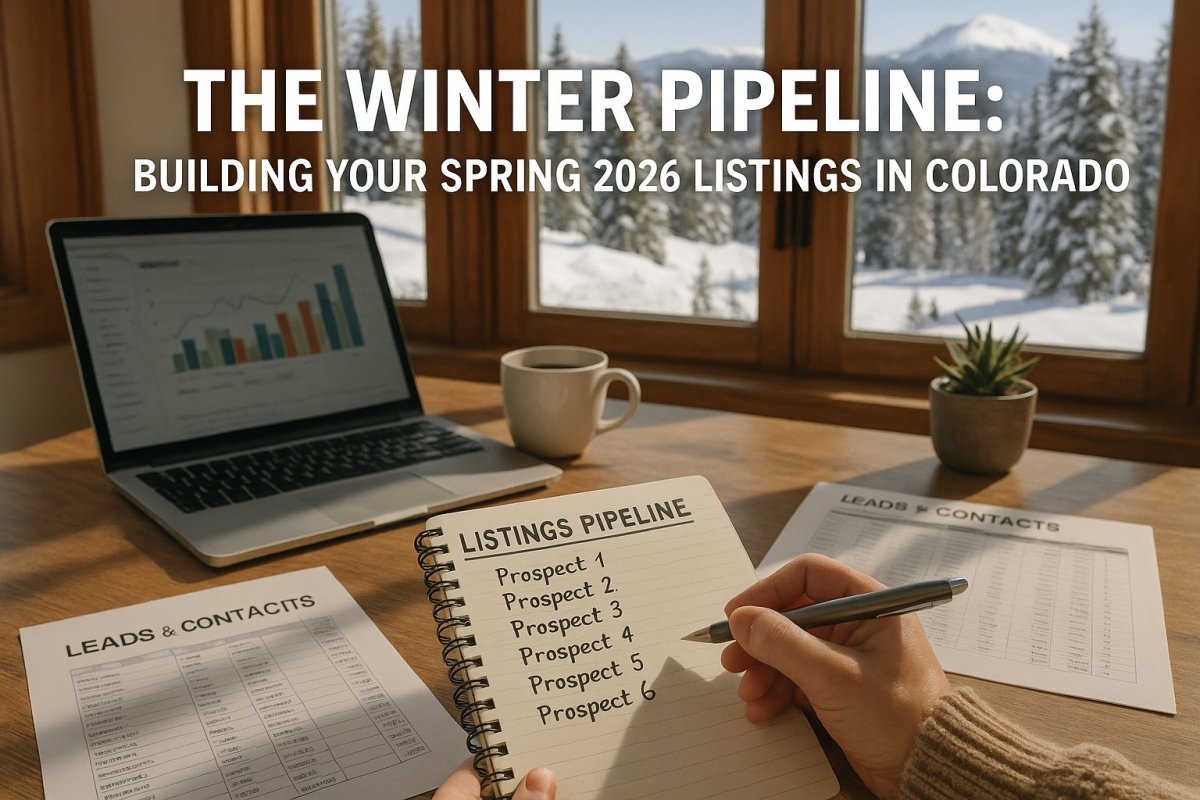The "Uninsurable Property Owner" is a high-urgency seller profile for a homeowner who is being forced to sell due to the inability to secure or afford homeowner's insurance, often because of a high-risk feature like an old roof or new HOA assessments.
Executive Summary: In 2026, the lever moving many Colorado sellers won’t be a rate headline—it will be total monthly cost. Insurance premiums, deductibles, roof exclusions after hail cycles, and HOA dues/special assessments in condo/townhome corridors are quietly creating must-move decisions. For owners who thought a 3% first mortgage guaranteed permanence, the new math says otherwise. This guide gives Colorado agents a complete operating system to find, educate, and serve these cost-shock sellers. We cover a practical signal stack, building/HOA diagnostics, condo financeability checks, payment-oriented listing strategies, and the scripts and net sheets that convert concern into action. Read it alongside our guides on "Mastering Micro-Markets," the "Locked-In Effect," the "HELOC Squeeze," finding "Trapped Equity Downsizers," and the "2026 Colorado Housing Outlook" to run a cohesive plan.
1) The new seller math: “payment pain” beats “rate pride”
Many owners will not give up their 3% mortgage rate—until their total monthly jumps enough to break comfort. In 2025–2026, two forces do most of the damage: (1) insurance premiums/deductibles and (2) HOA dues/assessments. For condos/THs, both often strike at once.
- Insurance: Rising base premiums; higher wind/hail deductibles; roof exclusions; secondary underwriting scrutiny for older systems.
- HOA & assessments: Reserve studies forcing catch-up, insurance costs passed to owners, post-2020s capex (roofs, elevators, envelopes), and in some cases financing/eligibility issues for buyers.
Result: owners who “should” be locked in become motivated to sell. Your advantage lies in detecting the shock early and providing a clear, respectful path out.
2) Where cost shocks concentrate in the Front Range
Use a micro-market lens (ZIP + property type + school zone + building/HOA overlay) to focus your effort.
| Corridor | Asset Type | Cost Shock Vectors | Resulting Seller Personas | Agent Angle |
|---|---|---|---|---|
| Downtown / DTC / parts of Aurora | Condo & Townhome | HOA dues up; special assessments; building insurance hikes | Payment-stressed owners; investor exits | Transparent dues/assessment framing; buyer credits/2-1 buydowns; financeability checks |
| South suburban belts (Centennial, HR, Littleton) | Detached (2000s–2010s roofs) | Premiums + hail deductibles; roof age issues | HELOC Squeeze overlap; family move-ups/downsizers | Pre-list roof strategy; condition transparency; modest credits vs. blunt price cuts |
| North corridor (Thornton → Brighton → Greeley) | Entry/mid detached & TH | Insurance increases hit payment-sensitive buyers/sellers hardest | Rate-elastic sellers; tired landlords | Fast-to-market packages; payment engineering on buy side to quicken DOM |
| Colorado Springs | Ranch homes; VA loan prevalence | Insurance + HOA in selected communities; PCS timing | Certainty-first sellers; VA assumability plays | Assumability audits; condensed timelines; rent-backs for logistics |
3) The signal stack: how to spot cost-shock sellers before they list
- HOA-level alerts: Dues increase notices; special assessment votes; reserve study summaries; insurance renewal letters.
- MLS behavior: Repeated price reductions; concessions become standard in certain buildings; “back on market” after financing hiccups.
- Insurance friction: Buyers report premium quotes or roof age issues killing deals nearby; sellers mention “our insurance doubled.”
- Owner conduct: Short-term renting to offset dues; deferred maintenance; HOA meeting chatter on social feeds.
- TimeToSell.AI personas: “Cost Shock,” “Insurance/Dues,” “Payment Pressure,” often overlapping with our "HELOC Squeeze" playbook.
Track these signals weekly inside your micro-market dashboard (see "Mastering Micro-Markets") and score cells for listing probability.
4) Building/HOA diagnostics: your pre-list checklist
Before you price a condo/TH listing, do building due diligence. It protects the seller and your days on market.
| Item | What to Ask/Verify | Why It Matters |
|---|---|---|
| Insurance Certificate | Premium trend; deductible structure; exclusions | Buyer financing and monthly payment risk |
| Reserves & Study | Reserve study date; funded %; planned capex | Assessment risk; buyer perception |
| Litigation/Defects | Open/closed cases; scope | Loan eligibility; buyer confidence |
| Owner-Occupancy | % owner-occupied vs. rentals | Condo financeability thresholds |
| Recent Assessments | Amounts, timelines, pay-off options | Contract structuring; disclosures |
For detached homes, pre-list insurance friction often centers on roof age/condition. Align roof documentation, repair bids, or insurance endorsements early.
5) Payment-first positioning: credits and buydowns that beat blunt price cuts
Cost-shock listings sell faster when you solve the buyer’s monthly. Here’s a pragmatic menu:
- Targeted closing credits: Aim credits at dues/insurance pain or to fund buydowns rather than large list-price reductions.
- 2-1 buydown (entry/mid bands): Especially effective in the north corridor and TH segments; lures buyers sensitive to first-year payments.
- Permanent buydown (mid/upper bands): In south suburban detached, permanent buydowns can outperform a $20–30k price cut in perceived monthly value.
- Assumability checks: For Springs, a 3% VA assumable can offset HOA/insurance pain for buyers and supercharge demand.
6) Math that moves decisions: “keep & carry” vs. “sell & reset”
Owners motivated by cost shocks respond to hard numbers, not platitudes. Use a simple side-by-side table:
| Line Item | Keep & Carry 12 Months | Sell & Reset | Notes |
|---|---|---|---|
| Mortgage (fixed) | $2,050 | $0 (paid off) or new smaller home | Low coupon isn’t the whole payment |
| Insurance | $260 → $410 | $150–$260 (smaller/newer) | Policy class & dwelling value shift |
| HOA/Assessments | $480 → $680 | $0–$350 (depends on next home) | Assessment removal is huge |
| Maintenance/Capex | $280 | $120 | Age/size dependent |
| Total Monthly | $3,070–$3,420 | $270–$1,620 | $1,400–$2,800/mo relief |
| Net Proceeds @ Sale | N/A | $160k–$380k | Equity redeployment |
For HOA-heavy units, explicitly show how a targeted seller credit (e.g., $10–12k) beats a $20k price cut in buyer monthly terms.
7) Scripts that reduce anxiety and open the door
Letter/Email: “Many owners in your community saw HOA and insurance costs jump in 2025. If your monthly feels different than it did two years ago, I can build a simple 1-page plan to eliminate the bleed without wasting your equity.”
Call opener: “I specialize in helping owners who have a great first mortgage but saw HOA/insurance costs surge. If you’d like, I can show you two or three clear paths that restore monthly comfort.”
Text follow-up: “I drafted a side-by-side for your address. Want me to email the numbers?”
8) Detached vs. Condo/TH: pricing and launch differences
Detached: Pre-inspection for roofs and obvious systems; price to live comps; modest credits if inspections surface deductible/policy hurdles. Condition speaks loudly to buyers nervous about premiums.
Condo/TH: Transparency wins trust. Publish dues/assessment details clearly; price realism + payment relief via credits/buydowns. Verify condo financeability before launch.
9) Financeability checks that save you from “back on market”
- Confirm owner-occupancy %, litigation, and budget/reserves against common lender overlays.
- Ask for recent closed loans in the building (conventional/VA/FHA) to gauge risk.
- Pre-brief buyer agents on HOA/insurance realities and where your credits can help their monthly.
10) Case briefs (Front Range)
A) DTC Townhome—Assessment Shock: HOA dues +18% and $9k assessment. We priced to 60-day comps, offered a $10k seller credit for buyer buydown/closing costs, and framed total monthly. Result: 17 days DOM, one clean offer, appraisal fine.
B) Highlands Ranch Detached—Insurance/roof friction: Premium jump + high wind/hail deductible. We did pre-inspection + roof tune-up, priced realistically, and offered a modest credit. Result: first weekend action, 99.2% of list.
C) Colorado Springs Condo—Insurance + HOA hike: Verified financeability early; positioned listing with assumability on the buy side for qualified buyers; provided dues/insurance transparency. Result: reduced fallout risk, DOM 21 days.
11) Micro-market scoring for cost shocks
Create a weekly Cost Shock Score (0–100) by cell (ZIP + asset type + building overlay):
| Component | Weight | Scoring Example | Why |
|---|---|---|---|
| HOA Dues Δ (12 mo) | 20% | +20 if ≥10% ↑; +10 if 5–9% ↑ | Direct payment shock |
| Assessment Incidence | 15% | +15 if current; +5 if likely | Seller creation event |
| Insurance Premium Δ | 20% | +20 if ≥20% ↑ est. | Monthly stress |
| Concessions Prevalence | 10% | +10 if concessions high | Payment relief required |
| DOM Tail (75th%) | 10% | +10 if rising ( caution ) | Pricing realism needed |
| Financeability Risk | 15% | +15 if clean; −10 if risky | Fallout probability |
| Investor Share | 10% | +10 if ≥25% | Exit propensity |
Cells ≥70 become prospecting priority; pull top 200 TimeToSell leads with “Cost Shock” or overlapping personas.
12) Operations: a 30/60/90-day plan
- Days 0–30 (Discovery): Build a list of buildings/HOAs with recent dues/assessment changes; create detached-roof friction map by age; align with a lender on condo overlays; craft a “Payment Relief Options” one-pager.
- Days 31–60 (Education & Offers): Host a 20-minute webinar per corridor (Downtown/DTC, South Suburbs, North Corridor, Springs). Offer free 1-page side-by-sides. Build a vendor bench for roof/insurance consults, HOA docs, and quick bids.
- Days 61–90 (Conversions): CMA + net proceeds worksheets; list with transparency-first copy; deploy credits/buydowns strategically; track DOM and feedback weekly.
13) Compliance and care
- Truthful advertising: Disclose dues/assessments and insurance context accurately; avoid promising future rate/insurance outcomes.
- Fair housing: Keep marketing focused on property utility and facts; avoid sensitive inferences.
- Neutrality on investor vs. MLS: Provide written net sheets for both; disclose relationships; encourage independent advice.
14) Copy & creative that sell “monthly comfort”
- Headline: “Transparent Dues • Payment Relief Options Available”
- Bullets: “Seller credit eligible toward 2-1 buydown or closing costs,” “Recent roof tune-up & documentation,” “Condo financeability verified.”
- Agent remarks: Provide lender contact ready to structure credits for buyer’s monthly target.
15) Objections & answers
“We’ll wait for dues to come down.” “HOA dues rarely reverse; assessments sunset but base dues typically persist. Let’s look at a smaller or different-cost stack where your monthly is predictable.”
“A price cut should be enough.” “A targeted credit can change the buyer’s monthly more than a headline cut. We’ll present both scenarios and choose the one that maximizes offers.”
“Condo buyers will balk at assessments.” “Some will—but transparency plus a buyer credit to offset payments wins serious buyers quickly. We’ll show the math upfront.”
16) Your field kit (checklists you can copy)
Pro Tip: Download these as a printable PDF checklist for your client files.
Condo/TH Intake: Insurance cert, reserves/meeting notes, litigation status, owner-occupancy %, assessment details, last 90-day loan closings in building, financeability confirmation.
Detached Intake: Roof age/docs, recent insurance quotes, wind/hail deductible notes, pre-inspection option, roof/repair bids.
Launch: Live-comp pricing, transparency-first copy, buyer credit menu prepared, lender pre-briefed.
17) KPIs that prove the model
- Lead-to-CMA acceptance for “Cost Shock” outreach: 20–35%.
- Listings acquired from HOA/insurance segments per quarter: goal 6–12 (team), 2–4 (solo).
- DOM vs. cell median when credits/buydowns used: target ≤ median.
- List-to-close ratio in transparent-copy listings: ≥98–100% depending on cell.
- Back-on-market rate: below corridor average due to pre-verified financeability.
18) Tie-ins to your broader system
- "Mastering Micro-Markets" — score cells and prioritize work where cost shocks cluster.
- "The Locked-In Effect" — language to neutralize “we can’t give up our 3%.”
- "The HELOC Squeeze" — second-lien pressure + dues is common in condo/TH corridors.
- "How to Find Trapped Equity Downsizers" — larger detached owners swap to lower-cost stacks.
- "2026 Colorado Housing Outlook" — understand scenario paths for pricing and DOM bands.
Final word: When costs jump, the monthly is what matters. Agents who master insurance and HOA transparency, engineer buyer payments with credits/buydowns, and verify financeability before launch will convert “we thought we were locked in” owners into confident 2026 sellers. Activate your free TimeToSell.AI account and use your $100 voucher to pull a “Cost Shock” lead list in your farm—then run this playbook with care and precision.
Proactive Protection: Smart Tools to Mitigate Risk
For homeowners concerned about the rising costs and risks associated with aging home systems, a small investment in modern smart home technology can provide both peace of mind and potential insurance discounts. These tools are excellent for detecting issues before they become catastrophic.
A common source of expensive home damage is slow leaks or burst pipes. Placing a set of ...protecting your home from water damage with a set of Govee WiFi Water Leak Detectors. in high-risk areas like under sinks, behind washing machines, or near the water heater can provide an instant alert to your phone, saving you from thousands in potential damages. Furthermore, ensuring your home is equipped with modern, reliable safety detectors is a requirement for most insurers. Upgrading to a set of interconnected, 10-year battery ...ensuring your home meets modern safety standards with a new set of combo smoke & CO detectors. is a critical step in protecting your property and family.





